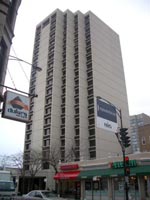Nobody was especially surprised when the Illinois Association of Realtors (IAR) announced last week that home prices had dropped in January 2008 when compared to prices in January 2007. The drop—2.2 percent in the Chicago area and 5.3 percent for the state of Illinois—was the first year-to-year price drop since at least 1998, when the IAR started tracking that statistic. There was one bright spot: the Chicago area did well compared to the nationwide price drop of 4.6 percent, as reported by the National Association of Realtors.
The IAR said that January’s median home price was $239,700 in the Chicago area, which in this report was a sprawling triangle whose points are at Kenosha, Gary, and Aurora. The median a year before had been $245,000. (The median is the exact midpoint in the range of house prices; in January 2008, half of Chicago’s houses sold for more than $239,7000, and half sold for less.)
Last week I looked into two homes that had sold recently at prices near the median to see what they can tell us about how houses get sold in this struggling market. There are lessons in these transactions for anyone hoping to buy or sell this spring.
 In Chicago, a one-bedroom condo in Lake View sold for $238,000, nearly 27 percent below the original asking price of $325,000. Add to that the two years of assessments that the seller is paying for the buyer—about $11,000 worth, according to the seller’s agent—and the buyer essentially paid $227,000. The seller had paid $310,000 for the condo in 2005.
In Chicago, a one-bedroom condo in Lake View sold for $238,000, nearly 27 percent below the original asking price of $325,000. Add to that the two years of assessments that the seller is paying for the buyer—about $11,000 worth, according to the seller’s agent—and the buyer essentially paid $227,000. The seller had paid $310,000 for the condo in 2005.
“Yes, he took a bullet,” says Gwen Hughes, the Koenig & Strey GMAC agent who represented the seller, “But that’s what you’re having to do to get something sold in this market. It was an irresistible bargain; the buyer was gleeful.
Hughes says the seller had to move because of his job, and that he had initially listed the condo for sale last April at “an optimistic price, but not asking for a huge profit.” At $325,000, the seller would have made a 4.8 percent profit after owning the condo for two years. As it became clear that values were dropping, he cut the price, first to the $280,000 range. He later asked Hughes what it would take to get the place sold in 30 days. She slashed the price to $250,000, and it was gone in three weeks. The sale closed February 26th. “Make your house an irresistible deal, and it will go,” Hughes says.
 In northwest suburban Hanover Park, a four-bedroom house that had been meticulously cleaned up and prepped for sale sold for $240,000, 11 percent below the original asking price of $270,000. Built in 1971, the house is in a neighborhood of large middle-class homes on streets that curve around a big park. The sellers, who had lived in the house about six years, had been transferred out of town. Before putting the house on the market, they did extensive cosmetic repairs. They ripped out overgrown shrubs that obscured the front windows, did some interior painting, and even replaced the dinged kitchen sink, according to their agent, Janet Sasso of Coldwell Banker. They also “staged” the house, removing clutter, excess clothing and furniture, and positioning the remaining furniture so it emphasized the big room sizes.
In northwest suburban Hanover Park, a four-bedroom house that had been meticulously cleaned up and prepped for sale sold for $240,000, 11 percent below the original asking price of $270,000. Built in 1971, the house is in a neighborhood of large middle-class homes on streets that curve around a big park. The sellers, who had lived in the house about six years, had been transferred out of town. Before putting the house on the market, they did extensive cosmetic repairs. They ripped out overgrown shrubs that obscured the front windows, did some interior painting, and even replaced the dinged kitchen sink, according to their agent, Janet Sasso of Coldwell Banker. They also “staged” the house, removing clutter, excess clothing and furniture, and positioning the remaining furniture so it emphasized the big room sizes.
“They spent a few extra dollars to make sure the house looked the best it could,” Sasso says. ”The house has to shine above all others to get noticed now, with so much inventory for sale.” The sellers also had the advantage, she says, of having been persnickety about home maintenance while living there. Appliances, furnace, wood siding, and other aspects of the home were all in top shape.
The sellers first listed the house for sale last fall at $270,000, but later cut the price to $240,000. In their listing, they announced in big type: “Huge price reduction. Seller wants a quick sale.” That brought out a buyer, and the sale closed February 22nd.
Sellers, Sasso says, are often discouraged in this market when they do so much to sell and still bring in a low price. But, she points out, “they will make it up on the buy side. They will find a great bargain to buy, too.”


